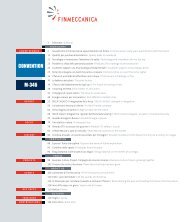E - Finmeccanica
E - Finmeccanica
E - Finmeccanica
You also want an ePaper? Increase the reach of your titles
YUMPU automatically turns print PDFs into web optimized ePapers that Google loves.
H I G H L I G H T S<br />
9/2010 FINMECCANICA MAGAZINE<br />
US DEFENSE:<br />
FUTURE<br />
EXPENDITURE<br />
David J. Berteau<br />
Senior Adviser and Director, Defense Industrial Initiatives Group’<br />
Center for Strategic and International Studies<br />
DESPITE THE BUDGETARY PRESSURES ON THE ACCOUNTS OF<br />
THE US DEPARTMENT OF DEFENSE, THE NEED TO TACKLE AND<br />
OVERCOME CURRENT CHALLENGES WILL REQUIRE THE US AD-<br />
MINISTRATION TO TAKE DECISIONS AIMED AT MAKING CON-<br />
TRACTS MORE EFFICIENT AND OPTIMISING COMPETITIVENESS<br />
For the past decade, European defense<br />
firms such as <strong>Finmeccanica</strong><br />
have seen growth in their revenue.<br />
The US independent think tank, the<br />
Center for Strategic and International<br />
Studies (CSIS), tracks the financial performance<br />
of European firms in a separate<br />
European Defense Index. That Index<br />
shows overall revenue growth of<br />
nearly 100 per cent since 2001, but it also<br />
shows that most of that growth has<br />
not been in Europe. European defense<br />
spending has declined steadily in the<br />
past 10 years, as CSIS will report in a<br />
new study to be released later this summer<br />
in Washington, DC. Our study<br />
shows that most of the growth has<br />
been in Asia, the Middle East, and the<br />
United States. This makes it important<br />
to understand what is likely to happen<br />
as increasing budget pressures impact<br />
spending by the US Department of Defense<br />
(DoD) over the next five to ten<br />
years.<br />
In late July, President Obama signed the<br />
Fiscal Year 2010 Supplemental Appropriations<br />
Act, adding USD 33 billion and<br />
bringing FY2010 DoD spending to more<br />
than USD 700 billion. FY2011 projections<br />
call for a similar number, although the<br />
final congressional figure may be slightly<br />
down. Of that total, roughly USD 400<br />
billion is spent on contracts for systems,<br />
research, and services. This total has<br />
doubled in the past ten years and has<br />
been the source of revenue growth for<br />
defense contractors, including those<br />
from Europe. DoD is dependent on the<br />
private sector for needed equipment,<br />
technology, services, and personnel sup-<br />
port, and those needs are not going<br />
away. But will that growth trend continue?<br />
Almost certainly, it will not.<br />
Last January, US Defense Secretary<br />
Robert Gates announced an Obama Administration<br />
commitment for one per<br />
cent annual growth in DoD spending.<br />
This seems promising, until we realize<br />
that there are three big challenges for<br />
future US defense spending and that<br />
none of these challenges will be solved<br />
by that one per cent growth in the defense<br />
budget.<br />
The first challenge for US defense<br />
spending is how to move away from the<br />
dependency on supplemental appropriations.<br />
Since 2001, Congress has provided<br />
DoD up to USD 200 billion per year in<br />
unbudgeted spending through supplemental<br />
appropriations for Overseas<br />
Contingency Operations (or OCO). In<br />
FY2010, total OCO funding will be more<br />
than USD 160 billion, designed to pay<br />
for the added costs of operations in Iraq<br />
and Afghanistan as well as support<br />
costs back home. A detailed look at<br />
what the money is spent for will show<br />
20 21
















